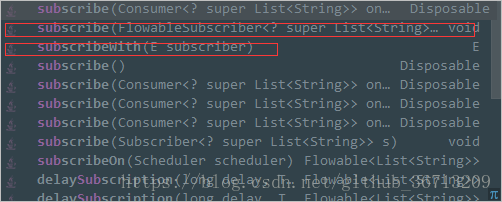1.定义接口地址
/**
* Created by PrinceOfAndroid on 2018/4/9 0009.
* 接口地址存放类
*/
public class ApiUrl {
//基本地址(要以“/”结尾)
public static final String BASE_URL = "";
//请求地址
public static final String ARTICLE_LIST = "";
}2.定义接口返回的数据类型
这里根据自己接口返回情况定制(返回数据类型一定要规范)
/**
* <pre>
* author : PrinceOfAndroid
* created : 2017/7/5 0005 11:50
* desc : 基本的接口数据返回类型
* </pre>
*/
public class HttpResponse<T> {
private int code; //状态码,由后台去定义(如code=200为成功)
private String message;
private T object; //泛型 最终使用的数据
public int getCode() {
return code;
}
public void setCode(int code) {
this.code = code;
}
public String getMessage() {
return message;
}
public void setMessage(String message) {
this.message = message;
}
public T getObject() {
return object;
}
public void setObject(T object) {
this.object = object;
}
}3.请求接口定义
/**
* Created by PrinceOfAndroid on 2018/4/9 0009.
*/
public interface BaseHttpService {
/**
* get 请求,参数以map的形式传入
*
* @param map
* @return
*/
@GET(ApiUrl.ARTICLE_LIST)
Flowable<HttpResponse<String>> getList(@QueryMap Map<String, String> map);
}如果不会的话,可看看retrofit2教程
这里申明返回一个Flowable,至于为啥是Flowable,去看看Rxjava2就知道Flowable有多强大。
4.构建retrofit
/**
* Created by PrinceOfAndroid on 2018/4/9 0009.
*/
public class RetrofitFactory {
private static BaseHttpService httpService = null;
public static BaseHttpService getInstance() {
if (httpService == null) {
synchronized (RetrofitFactory.class) {
if (httpService == null) {
return createHttpService();
}
}
}
return httpService;
}
private static BaseHttpService createHttpService() {
OkHttpClient client = new OkHttpClient.Builder()
.addInterceptor(new LogInterceptor()) //全局拦截器(这个就自己找个喜欢的拦截器)
.connectTimeout(8L, TimeUnit.SECONDS) //连接超时
.readTimeout(8L, TimeUnit.SECONDS) //读取超时
.build();
Retrofit retrofit = new Retrofit.Builder()
.client(client) //设置okHttp
.baseUrl(ApiUrl.BASE_URL) //基础地址
.addCallAdapterFactory(RxJava2CallAdapterFactory.create()) //引入rxJava2
.addConverterFactory(GsonConverterFactory.create()) //json 转换
.build();
httpService = retrofit.create(BaseHttpService.class);
return httpService;
}
}5.Subscriber的封装
/**
* <pre>
* author: PrinceOfAndroid
* date : 2017/7/5 0005 11:30
* desc : 网络请求结果封装(可处理Toast或dialog,但注意内存泄露问题)
* </pre>
*/
//这个只是基本功能,还可以通过构造方法传入一些值来做很多事情如:弹窗
public abstract class CommonSubscriber<T> extends ResourceSubscriber<T> {
@Override
public void onNext(T t) {
onSuccess(t);
}
/**
* 通过Throwable处理对应异常
* @param e
*/
@Override
public void onError(Throwable e) {
e.printStackTrace();
}
/**
* 完成
*/
@Override
public void onComplete() {
}
/**
* 根据具体的Api 业务逻辑去重写 onSuccess 方法!Error 是选择重写,but 必须Super !
*
* @param t
*/
public abstract void onSuccess(T t);
}这里我的CommonSubscriber是继承自ResourceSubscriber,至于为什么,后面会写到。
来个线程切换工具
/**
* Created by Administrator on 2018/3/20 0020.
* 线程调度
*/
public class RxUtils {
public static <T> FlowableTransformer<T, T> applyFSchedulers() {
return new FlowableTransformer<T, T>() {
@Override
public Publisher<T> apply(Flowable<T> upstream) {
return upstream.subscribeOn(Schedulers.io())
.observeOn(AndroidSchedulers.mainThread());
}
};
}
/**
* 预处理 code处理
*
* @param <T>
* @return
*/
public static <T> FlowableTransformer<HttpResponse<T>, T> handleResult() {
return new FlowableTransformer<HttpResponse<T>, T>() {
@Override
public Publisher<T> apply(Flowable<HttpResponse<T>> upstream) {
return upstream.flatMap(new Function<HttpResponse<T>, Flowable<T>>() {
@Override
public Flowable<T> apply(@NonNull HttpResponse<T> tHttpResponse) throws Exception {
if (tHttpResponse.getCode() == 200) {
return createData(tHttpResponse.getObject());
} else {
return Flowable.error(new ApiException("服务器返回error"));
}
}
});
}
};
}
/**
* 生成Flowable
*
* @param <T>
* @return
*/
public static <T> Flowable<T> createData(final T t) {
return Flowable.create(new FlowableOnSubscribe<T>() {
@Override
public void subscribe(FlowableEmitter<T> emitter) throws Exception {
try {
emitter.onNext(t);
emitter.onComplete();
} catch (Exception e) {
emitter.onError(e);
}
}
}, BackpressureStrategy.BUFFER);
}
}标题中说到的错误码集中处理就在handleResult()这个方法里了
还有 createData(final T t)中使用了BackpressureStrategy.BUFFER,就是标题中的背压
怎么使用呢?
很简单,几句代码就ok了
Map<String, String> map = new HashMap<>();
map.put("is_index", "true");
map.put("rows", String.valueOf("3"));
addSubscribe(iModel.getList(map)
.compose(RxUtils.<HttpResponse<String>>applyFSchedulers())
.compose(RxUtils.<String>handleResult())
.subscribeWith(new CommonSubscriber<String>() {
@Override
public void onSuccess(String s) {
Log.e("result", s);
}
}));里面有个iModel,里面代码如下
/**
* Created by PrinceOfAndroid on 2018/4/9 0009.
* 模型层,负责数据的处理
*/
public class LoginModel implements LoginContract.IModel {
/**
* @param map
*/
@Override
public Flowable<HttpResponse<String>> getList(Map<String,String> map) {
return RetrofitFactory.getInstance()
.getList(map);
}
}看到这里,有人会好奇,为什么是subscribeWith(),而不是subscribe()方法呢

看上图就知道,subscribe()是没有返回值的,而subscribeWith()返回了我们传进去的CommonSubscriber。
为什么要这个CommonSubscriber呢?这就要说刚刚写到的ResourceSubscriber了。

这里就知道ResourceSubscriber其实是实现Disposable实现方法如下
/**
* Cancels the subscription (if any) and disposes the resources associated with
* this AsyncObserver (if any).
*
* <p>This method can be called before the upstream calls onSubscribe at which
* case the Subscription will be immediately cancelled.
*/
@Override
public final void dispose() {
if (SubscriptionHelper.cancel(s)) {
resources.dispose();
}
}其实这个就是取消订阅,这个就是我标题写到的生命周期管理了。
有了这些就知道怎么去管理网络请求了,看上面的使用方法中会发现有一个addSubscribe()方法,里面传的就是我们的CommonSubscriber,里面就是对网络请求进行管理的,代码很简单。
protected void addSubscribe(Disposable subscription) {
if (mCompositeDisposable == null) {
mCompositeDisposable = new CompositeDisposable();
}
mCompositeDisposable.add(subscription);
}
protected void unSubscribe() {
if (mCompositeDisposable != null) {
mCompositeDisposable.clear();
}
}就是把Disposable 添加到CompositeDisposable中,需要取消订阅的时候如:activity或fragment已经关闭,直接调用
unSubscribe()方法,防止空指针。
这样一来基于retrofit2、rxjava2、OkHttp的网络请求封装就完成了。
如果对于retrofit2 rxjava2不熟悉可以阅读
https://juejin.im/post/5848d96761ff4b0058c9d3dc
https://blog.youkuaiyun.com/lmj623565791/article/details/51304204
如果想看源码的话,这里是地址:
https://github.com/PrinceOfAndroid/BaseProject





 本文介绍了一种基于Retrofit2、RxJava2及OkHttp的网络请求封装方案,包括定义接口地址、返回数据类型、请求接口、构建Retrofit实例以及管理网络请求生命周期的方法。
本文介绍了一种基于Retrofit2、RxJava2及OkHttp的网络请求封装方案,包括定义接口地址、返回数据类型、请求接口、构建Retrofit实例以及管理网络请求生命周期的方法。

















 被折叠的 条评论
为什么被折叠?
被折叠的 条评论
为什么被折叠?








